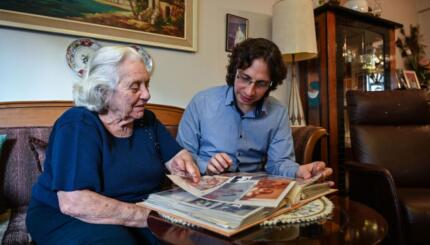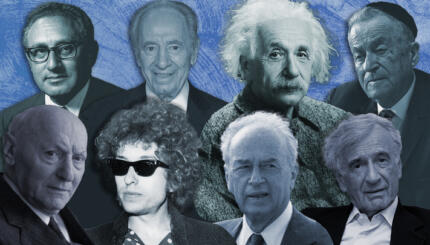The Jewish American writers of the 1920s and 1930s had mostly been telling a story of immigration and poverty, the romance of the New World, and urban despair. There had been variations on these themes, from Anzia Yezierska’s dirt-encrusted realism to Mike Gold’s Socialist-inflected visions of dystopia. Some writers, like Henry Roth, shared a profoundly personal view of the life of the Jewish immigrant, while others had seen it as symbolic of the social disorder that would one day, inevitably, lead to political change.
Writers like Yezierska and Gold were essential to the story of social upheaval that was affecting the Jews of the United States and their literature, but this story was at the margins of American literary culture. Jewish writers were, for the most part, standing outside the mainstream of American letters. After all, what did the garment workers on the Lower East Side have to do with Ernest Hemingway’s silent killers and burned-out soldiers, F. Scott Fitzgerald’s strivers and WASP aristocrats?
Out of the Ashes: Post-Holocaust Writing
The Second World War, and the postwar spread of Jewish prosperity, accelerated Jewish writers’ immersion into the American literary conversation. The melting-pot ideal, in which immigrants–and writers–had transformed themselves into deracinated Americans, was replaced by the salad bowl, in which immigrants maintained their identity while simultaneously forming part of the rich tapestry of American life. The changing ideal was reflected in American
With your help, My Jewish Learning can provide endless opportunities for learning, connection and discovery.
literature, which embraced a diversity of approach and subject matter as never before. From the poor whites of William Faulkner’s Yoknapatawpha County to the urban African-Americans of James Baldwin and Richard Wright’s work, American literature was opening its doors to those it had previously excluded. And Jewish writers were the largest beneficiaries of this sea change.
The 1950s saw Jews surging into the middle class, leaving the squalid tenements of the urban ghettos behind and fleeing, with so many other Americans, for the suburbs. Jews were now comfortably ensconced in American life, and the emerging writers of the postwar era–Philip Roth, Saul Bellow, Bernard Malamud, Grace Paley, Allen Ginsberg, and others–were devoted to simultaneously embracing, and rebelling against, that newfound prosperity. In so doing, they made Jewish characters, Jewish themes, and Jewish history part and parcel of the American story.
Postwar Jewish writers were often reflecting on their own immigrant or second-generation-immigrant parents, casting a scathing eye on the small hypocrisies and stifling consensus of the previous generation. Writers like Philip Roth were the eternal sons, their artistic work devoted, in large part, to slaying the father, again and again. Roth’s most famous novel, Portnoy’s Complaint (1969), was, among other things, a purposeful reveling in sexual chaos by a formerly polite Jewish boy, all of which was directed at his prudish parents.
Sex Sells
Sex was perhaps the biggest dividing line between the current generation and its elders, and many of the younger Jewish writers devoted themselves to a self-conscious embrace of the carnal as a primary literary topic. Saul Bellow, like Roth, refused to limit himself to acceptable “Jewish” topics, or Jewish characters. Bellow’s breakthrough novel, The Adventures of Augie March (1953), was picaresque, bursting with life and adventure and sexual dynamism. Bellow was an old-fashioned storyteller with a philosophical inclination and an abidingly modern interest in the sexual dynamics of contemporary relationships.
Allen Ginsberg made much of his own sexuality in his work as well. His unashamed same-sex lustiness was a contemporary update of Walt Whitman’s more encoded odes to the male body. Ginsberg was still Jewish in his inflections and his symbolic references; it was no accident that one of Ginsberg’s most famous poems, a tribute to his deceased mother, was called “Kaddish,” after the Jewish prayer for the dead.
The postwar Jewish writers also interjected themselves into the controversies of the day. Where a previous generation of American Jewish writers primarily occupied themselves with the parochial concerns of a tightly knit, self-enclosed community, their successors surged forcefully into the breach of the 1960s. The generation gap; the Vietnam War; the sexual revolution; the clash between liberalism and conservatism; these were the battles of the day, and the Jewish writers of the era were among the foremost commentators. Norman Mailer’s The Armies of the Night (1968) was subtitled “History as a novel,” documenting antiwar protests in something close to real time. Not all Jewish writers came down on the same side of the political divide. Bellow eventually threw in his lot with the cultural conservatives of the University of Chicago, while Roth was more aligned with the anti-Nixon sentiment and sexual license of 1960s liberalism.
Reacting to Religion
Jewish tradition, for Bellow and Roth, was often something to be eclipsed, transcended, or discarded with the other detritus of the unwanted past. But other Jewish writers of the era embraced the storytelling genius of the faith. Norman Mailer wrote about the Hasidic stories of Martin Buber, and Bernard Malamud emerged as an American successor to Isaac Bashevis Singer’s Yiddish-inflected stories of sin, guilt, and redemption.
Malamud’s stories, collected in books like The Magic Barrel (1958), and novels like The Assistant (1957) took place in a world half American lower-middle-class ghetto, half European shtetl. Malamud was unabashedly, unapologetically Jewish in his concerns and his approach, and yet this, too, was now an essential part of American literature. Malamud won the National Book Award in 1959 for The Magic Barrel, five years after Bellow’s win for Augie March, and a year before Roth’s for Goodbye, Columbus. Malamud would win a second National Book Award, in 1967, for The Fixer (Bellow would win again, in 1971, for Mr. Sammler’s Planet, and Roth in 1995 for Sabbath’s Theater.)
Roth, Bellow, and Malamud’s new Jewish literature would be a harbinger of changes to come in American letters. They took part in paving the way for all manner of minority voices that had not much been heard before in the U.S.—female writers, African-Americans, and Hispanics among them. A new generation of contemporary Jewish writers followed in the postwar Jewish titans’ footsteps. Authors like Nicole Krauss, Gary Shteyngart, Michael Chabon, and Jonathan Safran Foer have combined Jewish tradition and Jewish history with a postmodern, self-referential style of storytelling. These new writers may not be quite as central to American literature as their predecessors had been, but then the rise of Bellow, Roth, Malamud and the other Jewish giants was a product of the time and the place, and is unlikely to ever be repeated.



